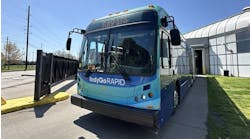At first glance, the idea of reducing King Street in Hamilton by one lane from John Street all the way to Dundurn probably seems questionable to many people. But give it a chance and some thought. You might come around to the view, as we have, that it's actually a very sound experiment in transit and traffic management that deserves a shot.
The city's public works committee has approved a pilot project that will see King reduced by a lane to create a bus-only lane during weekday rush hours, 7 a.m.-9 a.m. and 3:30 p.m.-6:30 p.m. Staff believes the transit-only lane project will help with the speed and reliability of transit service by separating buses from the overall traffic flow. That should improve HSR on-time service as well as raise the profile of transit, hopefully boosting ridership, or at least making transit seem a more viable option.
Skeptics are already panning the idea, but they should consider a few things. Even now, the north lane of King is being used for much of the day by buses and other service vehicles. It's not a clear shot through the core on King by any means. In addition, construction at the Good Shepherd Centre project at 398 King West has required closure of the north-side curb lane for the better part of a year and, according to staff research, that has not resulted in significant traffic impacts.
Another reason we like this experiment is that it tests the viability of a dedicated transit corridor, which is something the city will need when and if it secures light rail transit, or for that matter the cheaper - and less impactful - alternative of bus rapid transit.
But of course, there is a downside. Curb lane parking will be lost to businesses on the north side of King along the affected corridor during weekday rush hours. That's not a small matter for establishments already struggling through difficult economic times. As downtown councillors Jason Farr and Brian McHattie have noted, it's important there be meaningful consultation with business owners, and that their concerns are given adequate consideration.
There will also be a learning curve for drivers, because for this to work, right turns will need to be prohibited during rush hours at intersections including Hughson, James and Locke. Without that prohibition, cars waiting to turn will block the curb lane and neutralize any benefits. The bus lane will be marked with diamonds and overhead signs, but even so, drivers will take some time to adjust to the new routine when and if the program is launched in summer 2012, as recommended in the staff report.
Overall, this is an innovative proposal worthy of support, provided adequate consultation and flexibility are brought to bear to mitigate negative outcomes. We would encourage city council to get on board when the idea goes for ratification later this month.
Copyright 2008 LexisNexis, a division of Reed Elsevier Inc. All rights reserved.
Terms and Conditions | Privacy Policy


